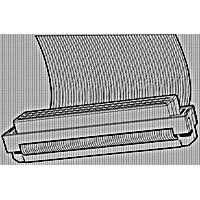Features: • Fast access times: 3.5, 3.8, and 4.0ns
• Fast clock speed: 166, 150, 133, and 117MHz
• Provide high performance 3-1-1-1 access rate
• Fast OE# access times: 3.5ns and 3.8ns
• Optimal for depth expansion (one cycle chip deselect to eliminate bus contention)
• 3.3V -5% and +10% core power supply
• 2.5V or 3.3V I/O supply
• 5V tolerant inputs except I/O's
• Clamp diodes to VSSQ at all inputs and outputs
• Common data inputs and data outputs
• BYTE WRITE ENABLE and GLOBAL WRITE control
• Three chip enables for depth expansion and address pipeline
• Address, data and control registers
• Internally self-timed WRITE CYCLE
• Burst control pins (interleaved or linear burst sequence)
• Automatic power-down for portable applications
• Low profile 119 lead, 14mm x 22mm BGA (Ball Grid Array) and 100 pin TQFP packages
Pinout Specifications
SpecificationsVoltage on VCC Supply Relative to VSS...... ..-0.5V to +4.6V
VIN ........................................................... -0.5V to VCC+0.5V
Storage Temperature (plastic) .......................-55oC to +150o
Junction Temperature ...................................................+150o
Power Dissipation ......................................................... .1.0W
Short Circuit Output Current ..........................................50mA
*Stresses greater than those listed under "Absolute Maximum Ratings" may cause permanent damage to the device.This is a stress rating only and functional operation of the device at these or any other conditions above those indicated in the operational sections of this specification is not implied. Exposure to absolute maximum rating conditions for extended periods may affect reliability.
DescriptionThe Galvantech Synchronous Burst SRAM family employs high-speed, low power CMOS designs using advanced triple-layer polysilicon, double-layer metal technology. Each memory cell consists of four transistors and two high valued resistors.
The 6514 SRAM integrates 262,144x18 SRAM cells with advanced synchronous peripheral circuitry and a 2-bit counter for internal burst operation. All synchronous inputs are gated by registers controlled by a positive-edge-triggered clock input (CLK). The synchronous inputs include all addresses, all data inputs, address-pipelining chip enable (CE#), depth-expansion chip enables (CE2# and CE2), burst control inputs (ADSC#, ADSP#, and ADV#), write enables (WEL#, WEH#, and BWE#), and global write (GW#).
Asynchronous inputs include the output enable (OE#) and burst mode control (MODE). The data outputs (Q), enabled by OE#, are also asynchronous.
Addresses and chip enables are registered with either address status processor (ADSP#) or address status controller (ADSC#) input pins. Subsequent burst addresses can be internally generated as controlled by the burst advance pin (ADV#).
Address, data inputs, and write controls are registered onchip to initiate self-timed WRITE cycle. WRITE cycles can be one to four bytes wide as controlled by the write control inputs. Individual byte write allows individual byte to be written. WEL# controls DQ1-DQ8 and DQP1. WEH# controls DQ9-DQ16 and DQP2. WEL#, and WEH# can be active only with BWE# being LOW. GW# being LOW causes all bytes to be written. WRITE pass-through capability allows written data available at the output for the immediately next READ cycle. This device also incorporates pipelined enable circuit for easy depth expansion without penalizing system performance.
The 6514 operates from a +3.3V power supply. All inputs and outputs are LVTTL compatible. The device is ideally suited for 486, PentiumTM, 680x0, and PowerPCTM systems and for systems that are benefited from a wide synchronous data bus.

 6514 Data Sheet
6514 Data Sheet









